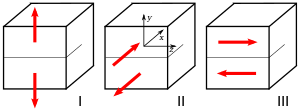زلزال قص فائق
| جزء من سلسلة مقالات عن الزلازل |
|---|
| الأنواع |
|
هزة سابقة • هزة تابعة • الدفع الأعمى مزدوج • بين الصفائح • داخل الصفيحة الدفع الهائل • مثارة عن بعد • بطيء تحت الماء • قص فائق تسونامي • Earthquake swarm |
| الأسباب |
| حركة الفوالق • نشاط بركاني • Induced seismicity |
| الخصائص |
|
مركز الزلزال • بؤرة الزلزال • منطقة الظل موجة سيزمية • الموجة پي • الموجة إس |
| القياس |
|
مقاييس زلزالية • السيزموگراف مقياس مدة الزلزال |
| التنبؤ |
|
اللجنة المنسقة لتوقع الزلازل حساس بالزلازل |
| أخرى |
|
فصم موجة القص • معادلة أدمز-وليامسون مناطق فلين-إنگدال • هندسة الزلزال Seismite • علم الزلازل |
زلزال قص فائق supershear earthquake، هو زلزال يتميز بالسرعة العالية لانتشار التمزق على طول سطح الصفيحة in excess of the seismic shear wave velocity. This causes a form of sonic boom to occur.[1]
سرعة انتشار التمزق
During seismic events along a fault surface the displacement initiates at the focus and then propagates outwards. Typically the focus lies towards one end of the slip surface and much of the propagation is unidirectional (e.g. the 2008 Sichuan and 2004 Indian Ocean earthquakes). Theoretical studies have in the past suggested that the upper bound for propagation velocity is that of Rayleigh waves, approximately 0.92 of the shear wave velocity.[2] However, evidence of propagation at velocities between S-wave and P-wave values have been reported for several earthquakes[3][4] in agreement with theoretical and laboratory studies that support the possibility of rupture propagation in this velocity range.[5][6]
حدوثه
أمثلة
لوحظ بشكل مباشر
- زلزال إزمت 1999، بقوة، Mw 7.6 صاحبه حركة إنزلاق في North Anatolian Fault Zone[7]
- زلزال كونلون 2001، بقوة، Mw 7.8 صاحبه حركة إنزلاق في Kunlun fault[8][9]
- زلزال دنالي 2002، بقوة، Mw 7.9 صاحبه حركة إنزلاق في Denali Fault[10][9]
- 2010 Yushu earthquake, magnitude Mw 6.9 associated with strike-slip movement on the Yushu Fault[11]
أُستدل عليه
- زلزال سان فرانسيسكو 1906، بقوة Mw 7.8 صاحبه حركة إنزلاق في San Andreas Fault[12]
- زلزال إمپريال ڤالي 1979، بقوة Mw 6.4 صاحبه حركة إنزلاق في Imperial Fault[3]
انظر أيضاً
المصادر
- ^ A century after the 1906 earthquake, geophysicists revisit 'The Big One' and come up with a new model, Press release, Stanford University
- ^ Broberg,K.B. 1996. How fast can a crack go?. Materials Science, 32, 80-86
- ^ أ ب Archuleta,R.J. 1984. A faulting model for the 1979 Imperial Valley earthquake, J. Geophys. Res., 89, 4559–4585.
- ^ Ellsworth,W.L. & Celebi,M. 1999. Near Field Displacement Time Histories of the M 7.4 Kocaeli (Izimit), Turkey, Earthquake of August 17, 1999, Am. Geophys. Union, Fall Meeting Suppl. 80, F648.
- ^ Okubo, P. G. (1989). Dynamic rupture modeling with laboratory-derived constitutive relations, J. Geophys. Res. 94, 12321-12335
- ^ Rosakis,A.J., Samudrala,O. & Coker,D. 1999. Cracks Faster than the Shear Wave Speed. Science, 284. no. 5418, pp. 1337 - 1340
- ^ [1] Bouchon, M., M.-P. Bouin, H. Karabulut, M. N. Toksöz, M. Dietrich, and A. J. Rosakis (2001), How Fast is Rupture During an Earthquake ? New Insights from the 1999 Turkey Earthquakes, Geophys. Res. Lett., 28(14), 2723–2726.]
- ^ Bouchon,M. & Vallee,M. 2003.Observation of Long Supershear Rupture During the Magnitude 8.1 Kunlunshan Earthquake, Science, 301, 824-826.
- ^ أ ب Walker, K.T. (2009). "Illuminating the near-sonic rupture velocities of the intracontinental Kokoxili Mw 7.8 and Denali fault Mw 7.9 strike-slip earthquakes with global P wave back projection imaging" (PDF). Journal of Geophysical Research. 114 (B02304). doi:10.1029/2008JB005738. Retrieved 1 May 2011.
{{cite journal}}: Unknown parameter|coauthors=ignored (|author=suggested) (help) - ^ Dunham,E.M. & Archuleta,R.J. 2004.Evidence for a Supershear Transient during the 2002 Denali Fault Earthquake, Bulletin of the Seismological Society of America, 92, S256-S268
- ^ Wang, D. (2012). "The 2010 Qinghai, China, Earthquake: A Moderate Earthquake with Supershear Rupture". Bulletin of the Seismological Society of America. Seismological Society of America. 102 (1): 301–308. doi:10.1785/0120110034. Retrieved 24 April 2012.
{{cite journal}}: Unknown parameter|coauthors=ignored (|author=suggested) (help) - ^ Song,S. Beroza,G.C. & Segall,P. 2005. Evidence for supershear rupture during the 1906 San Francisco earthquake. Eos.Trans.AGU, 86(52), Fall Meet.Suppl., Abstract S12A-05
